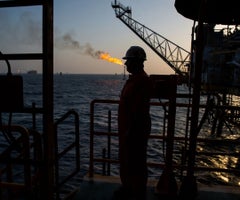MI SELECCIÓN DE NOTICIAS
Noticias personalizadas, de acuerdo a sus temas de interés

By Spencer Jakab
No, the laws of supply and demand haven’t been suspended when it comes to oil and Iran.
The 15% plunge in Brent crude futures in the past month, coming ahead of Monday’s reimposition of sanctions on oil exports, makes sense. What comes next is a lot more complicated.
Iranian exports dropped by around 800,000 barrels a day between June and September and may fall further, but the market has been able to cope for now. Analysts at RBC Capital Markets think the decline could reach between 1.3 million and 1.7 million barrels a day by the first quarter of 2019.
The market didn’t panic because Iranian production fell only about half as much as its exports, according to the Organization of the Petroleum Exporting Countries. Before its production is seriously curtailed, Iran can fill onshore and then more expensive floating storage with tens of millions of barrels. While exports probably fell sharply again in October, they should rebound this month because the Trump administration announced significant 180-day waivers for large buyers of Iranian crude, including India and China.
One reason prices spiked to a four-year high in early October was that it became clear rising output from Saudi Arabia and Russia wasn’t going to be enough to plug the hole left by Iran. U.S. shale supply growth remains temporarily stymied by infrastructure bottlenecks. The International Energy Agency estimates that the market will be in a deficit of about 200,000 barrels a day this quarter compared with a surplus of 300,000 barrels a day during the second quarter, before sanctions were reimposed.
For now, it has helped that Iranian supply is falling during a typically slack period for oil consumption as many refineries enter turnarounds following the summer driving season. U.S. midterm elections also helped. Even as he planned far harsher sanctions on Iran than the Obama administration, President Trump complained over the summer that oil prices were too high-presumably with an eye on taming potential voter ire over pump prices. While cajoling OPEC could only go so far, hints in recent weeks that sanctions might be flexible have spooked speculators in the market, pressuring prices.
If global economic growth doesn’t slow due to a trade war and if sanctions tighten considerably next spring, the first half of 2019 could see a significant rebound in prices. That might be short-lived, though, because U.S. output is expected to roar ahead by mid-2019.
Iranian output fell by 1 million barrels a day from peak to trough under the previous nuclear sanctions. Once global output can fully replace Iran’s blocked exports-perhaps next summer-the sanctions could get far tougher.
En junio, Putin dijo que Rusia pondría fin a la guerra en Ucrania, sólo si Kiev accedía a abandonar sus ambiciones en la Otan
Harris selló su estatus como presunta nominada tras superar el número de 1.976 delegados comprometidos según estimaciones
La cadena tuvo problemas para la recuperación de las finanzas a los niveles de la prepandemia. Afiliados pasarán a SmartFit